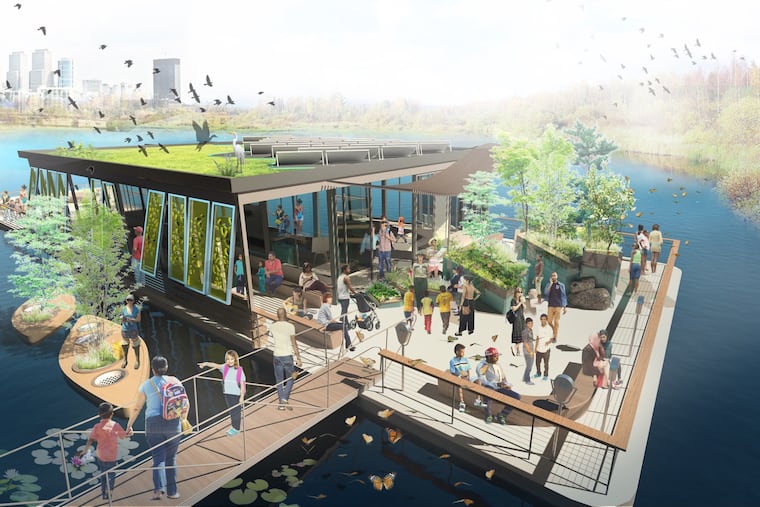Philly plans to create a large ‘floating classroom’ on the Schuylkill near Fairmount Dam
The Philadelphia Water Department has plans to create a floating "outdoor classroom" in the Schuylkill in front of Fairmount Water Works, according to documents submitted to the U.S. Army Corps. of Engineers.

The Philadelphia Water Department plans to create a floating “outdoor classroom” in the tidal Schuylkill near the Fairmount Water Works, according to documents submitted to the Army Corps of Engineers.
The project would be built along the east bank of the Schuylkill, immediately downstream of the Martin Luther King Drive Bridge and almost parallel with the Philadelphia Museum of Art.
The floating classroom would consist of a 5,400-square-foot structure anchored in the water, with almost 1,000 square feet of floating docks tied to it. Two ramps would connect the structure to a 1,000-square-foot platform next to the river.
It would also connect to the Schuylkill River Trail via a walkway. The goal is to educate children and the general public on water quality and conservation. It is also designed for boat access.
The plans do not include an estimate of the project’s cost or time frame for when it would be built, and there was no mention of whether the coronavirus pandemic would have an impact on timing. And it would have to go through a permitting process.
“The outdoor classroom is still a project in development, energized by our amazing freshwater mussel hatchery at the Fairmount Water Works Interpretive Center” (FWWIC), spokesperson Laura Copeland said in an email. “The Floating Water Workshop, as the mussel hatchery does, furthers PWD/FWWIC’s mission to connect our residents to their water environment.”
The project is a collaboration with regional partners, and money is being raised through donors, she said.
The plans require a permit from the Army Corps, which will determine probable impacts on the environment, aesthetics, floodplain issues, and other concerns. (The Schuylkill is tidal up to the Fairmount dam, and the classroom would be able to be raised during a flood.)
Copeland said the permitting process will “ensure that the project will not have any harmful impact on the river’s ecosystem.” PWD is also applying for permits from the Pennsylvania Department of Environmental Protection and National Marine Fisheries.
The classroom would add to another public-access improvement in the area in recent years: a $4.2 million boardwalk and trail on the river that opened in 2018. The 380-foot boardwalk juts over an island, offering an elevated view of the nearby Fairmount Water Works, the Art Museum, and Boathouse Row.
The classroom would be open six months out of the year, from June through November, as an extension of the Fairmount Water Works. From December to May, the structure would be moved to an enclosed basin at Penn’s Landing.
Its size should enable large classes to be held on the river, though plans were not specific as to the number of people it could accommodate.
Though plans were ready in January, a public notice was posted by the the Army Corps in mid-April. The corps has just finished soliciting comments from the public, as well as from federal, state and local agencies, on the project. Federal officials will then decide if a public hearing is needed.
The plans drew some backlash from anglers, who say it could impact shad because of that location.
Bill Gordon, a member of the Delaware River Shad Fishermen’s Association, regularly fishes for shad in the area where the platform would be built. He said it is one of the few banks accessible to anglers.
Gordon, of Media, said the classroom would be a threat to shad, which have made a big recovery in the river, because it would provide cover for invasive species that feed on the fish, such as snakeheads and flathead catfish.
“The classroom would essentially cover all of the area that is now open,” Gordon said. “Right now, it’s a good fishery and there are a lot of fish to be caught.”